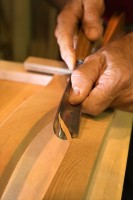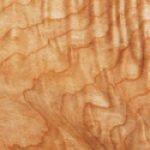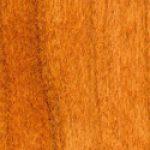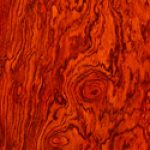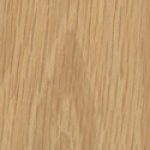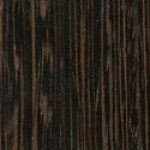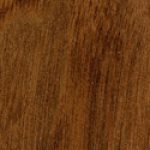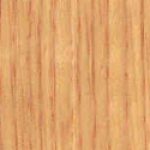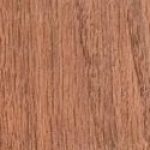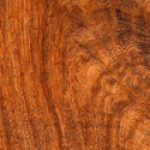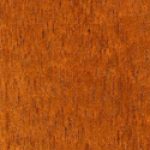Austin Joinery only uses the best materials. Every nut, bolt, drawer slide, hinge, and handle is the very best quality we can source and appropriate to your specific purchase. Our hardwood comes from a wide variety of locally-owned lumber yards that offer Forest Steward Council (FSC) lumber.
Craftsmanship
Everything we build is designed and constructed to provide the utmost functionality and durability. Unless there’s a good reason to do otherwise, joints are mortise-and tenon and then either glued together using a high-quality wood glue, or fastened using wood screws. Screws are a great way to reinforce the piece, but still permit the owner to disassemble it, when necessary.
Woods Used
Austin Joinery™ can build products out of most wood types you desire. We firmly believe in the concept of environmental sustainability and source our woods with that goal in mind. Some of the more frequently requested woods:
- Lacewood
- Hard Maple
- Curly Maple
- Cherry
- Bubinga
- Bird’s Eye Maple
- Alder
- Zebra
- White Oak
- Wenge
- Walnut
- Riftsawn
- Red Oak
- Pecan/Hickory
- Oak
- Mesquite
- Mahogany
Pecan ($). The terms Hickory and Pecan are often interchangeable in the furniture world, because the woods are so similar. Per someone smarter than us: The two are the same genus, but different species. Hickory is self pollinating, Pecan isn't. Both are lightly-colored, inexpensive, and sturdy -perfect for furniture. The grain pattern is sometimes mistaken for oak. The material cost, strength, and beauty make it a great choice!
Alder ($). Alder is part of the birch family; it is a softer hardwood from the Pacific Northwest. Consistent color, stability, and uniform acceptance of stains and finishes are some of the characteristics that have made Alder a preferred wood for furniture. Its elasticity makes it ideal for carving intricate details. Ranking second only to oak as the most commonly used wood, alder offers the look of many fine hardwoods at a value price. Alder is also available in what lumber yards call a "rustic" or "knotty" alder which is simply alder with knots and minor cracks.
Oak ($-$$). Oak is hard, strong, and reasonably priced. Unlike many other woods, it is commonly sold in various cuts, hence the "$-$$" range. Plainsawn ($), Riftsawn ($$) and Quartersawn ($$) are the most common cuts. Each cut produces are distinct grain pattern. Customers have two readily available options when it comes to oaks: red oak or white oak. Both are great for furniture; although, many say red oak has more of a reddish-brown tint and prominent grain pattern, whereas white oak has more of an olive color and smoother texture. Oak is a solid choice that makes enduring furniture.
Maple ($-$$$). Sometimes called sugar maple or rock maple. It is among the largest and most sourced hardwoods. Many might recognize the tree as the source of maple syrup. Maple has been a favorite of American furniture makers since early Colonial days. It is extremely tough, which makes it great for everything from flooring to furniture. Maple has an attractive flowing grain that takes stain very well. It can be finished in a wide range of shades. Maple is an excellent choice if you want to reduce the material cost of your custom furniture, yet have something that's tough as nails and still looks like a million bucks. Maple comes in a wide range of cuts ranging from natural soft ($) which is commonly used for paint-grade projects all the way through naturally beautiful cuts like curly ($$) or birds-eye maple ($$$)
Mahogany ($$). A ubiquitous wood with many species, Mahogany is a medium-density wood that’s one of our favorites to build with. It’s easy to work with, and durable. Mahogany makes some of the most beautiful furniture you have ever seen. Mahogany has tight grain patterns and colors that can range from a creamy-white and yellow to reddish or dark brown. It is a beautiful choice for any household or office.
Cherry ($$). Cherry is easy to work with and makes elegant furniture. It darkens and slightly reddens with age giving it a warm look. The key to keeping the color consistent is to keep it in even light. Cherry is a good choice for projects with carvings because it has a beautiful, soft grain-pattern. Our Trinity Entry Table is a great example. Cherry is also available in what lumber yards call a "rustic" or "knotty" alder which is simply alder with knots and minor cracks.
Mesquite($$$). Hard, gnarled, thorny, and is extremely tough - just like Texas. We get our mesquite directly from guys clearing their part of the hill country with chainsaws. Finishing mesquite takes proper skill, because of its' naturally occurring cracks and holes; however, the final product is absolutely amazing. Even a piece accented with mesquite will subtly say Texas.
Walnut ($$$). Walnut is the Cadillac™ of furniture woods. It is sturdy, beautiful, and prized for its flowing grain patterns. Perfect for enduring pieces of furniture. A single glimpse of well-built walnut furniture will catch anyone's eye.
Lacewood ($$$). The conspicuous flecking of this wood gives it its name. Lacewood is reddish brown with grey or light brown rays, resulting in a lace pattern when quartersawn. The darker you stain Lacewood, the more pronounced the grain pattern is - truly eyecatching.
Bubinga ($$$). This hardwood has great medium to dark brown grain patterns; it is perfect for high-end furniture. Bubinga is often used in guitars, harps, and drum shells for its tonal qualities. The use of Bubinga in your piece will elevate the aesthetic of any room.
Zebrawood ($$$$). Not surprisingly, Zebrawood has dark brown and yellowish stripes for grain. It’s best used as an accent wood since it’s not cheap. Zebrawood is perfect for small items like a humidor or as an accent piece on larger furniture.
Wenge ($$$$). Pronounced “wang”, this wood has a chocolate and dark brown striped grain pattern. Cutting it makes the shop smell like chocolate. Like Zebrawood, Wenge is best used for smaller pieces or accents. The best example of Wenge is on our Sabine Executive Desk.

